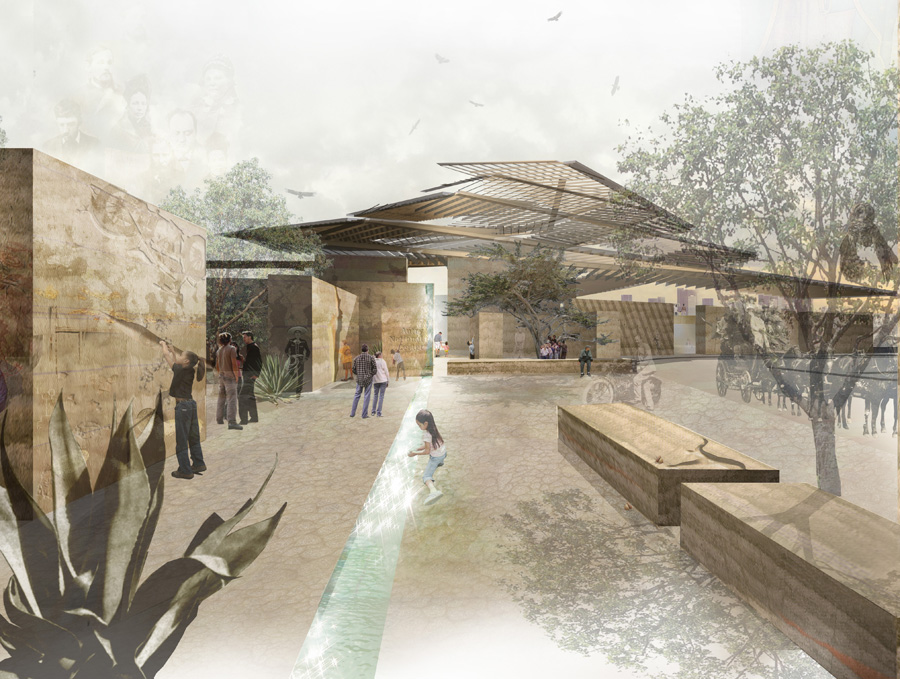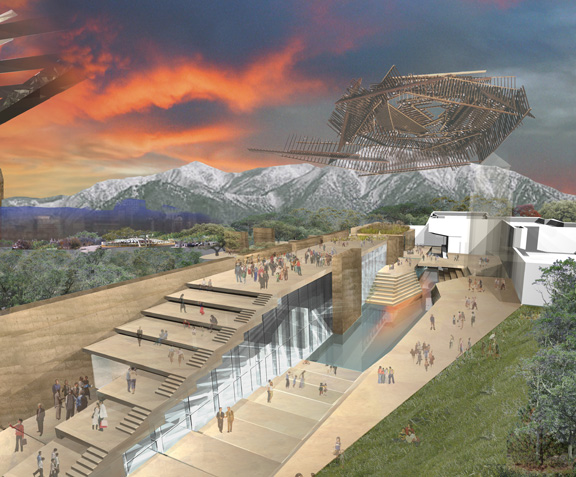
|
|

|
Autry National CenterLos Angeles, CaliforniaOur proposal for the New Visitors Service Pavilion of the Autry National Center engages the Western multi-cultural milieu with a layered journey through a symbolic diagram of Native American cosmology, suggesting the three worlds of their spiritual beliefs. Simultaneously the Entry and the Great Lawn beyond create an embracing internal space. Every turn rife with informative and exploratory opportunities, with gathering areas for all; children, families, classes, educational and fundraising events. It is an architecture of sustainability, speaking of the earth, from the rammed earth walls to the flow of water in the Zanja/ Cistern and the recycled aluminum structure of the Ramada/Nest. The new entry of the Autry National Center abstracts the movement of water that has sustained native populations on through to the present day’s diverse cultures in the Los Angeles Basin. The movement of water, the Zanja/ Canal implies the memory of Los Angeles River, beginning in the arid San Fernando Valley at the base of the San Gabriel and Santa Susana Mountains to the ocean, and leads visitors toward the Gorge/ Amphitheater, through the Zaguan, aligned with the equinox sunrise. The journey through the Center begins with a focused view of the Zaguan passage, and above, the floating Ramada/ Nest, recalling a Tongva shelter and symbolic of the eagle Slo’w’s outstretched wings supporting the Upper World. The Entry Court is an inviting labyrinth of earthen walls of memory – outdoor rooms and gathering places – holding and displaying, as imprint and spirit, a cross section of Los Angeles’ geological and anthropological history, bringing material culture to the fore in a context of exploration and learning. The Visitor Service Pavilion, accessed via the Zaguan, is an enclosed passage of diffuse light. It orients the visitor to the content and context of the Autry National Center. As in the Entry forecourt, art and objects outside of the museum realm key to the collections, to the library and to the gathering lawn beyond. Saddles, spurs and sombreros speak of Los Angeles’ western heritage. Dugout and plank canoes are suspended from the ceiling. Kachinas, baskets, soft soapstone pots and hunting tools hint at the rich collection of Native American history. The view over the Gorge/ La brea, is toward the San Gabriel Mountains and Mount San Antonio, focal points with aligned paths. The Pleiades hovers above, the mythic flock of geese morphed into stars, symbolic of fraternal struggle and release. The Gorge/ Amphitheater beneath the Ramada/ Nest is, as a symbol of the Middle World, the place of community and gathering at the convergence of life, of water, of man, of animal, of spirit. It is encoded with fragments of mineral and stone, precious to both native peoples and western settlers. Glass lined bleachers bring light into and reveal the curatorial spaces below inviting gathering and pause. Much like a gathering space in native villages, the Gorge is oriented to celestial events – equinox and solstice, sunrise and sunset. The Community Room, glowing with winter fire, inhabits this juncture with the channel of the Zanja, leading to the Oasis/ La brea Cistern. Recalling Thunder’s creation of Zaca Lake, the Cistern is filled with water as the portal between the Middle World and the Other World, where Swordfish prevails as king of sea creatures over the shape shifting Coyote. The rooftop terrace becomes inhabited, reminiscent of pueblo villages, giving the visitor an open vista of heavens and horizon, observing and marking the movement of time.
|
|
||||||||||||||||
|
|